

Flowlab resources. Video Tutorials Step by step demonstration of creating a simple game with flowlab.

Getting Started with the Game Builder Step by step introduction to using Flowlab. This guide walks through all the steps required to get started building a simple game. Neuroimaging in Python - Pipelines and Interfaces — nipy pipeline and interfaces package. FBP for Mind Maps. Headspace. Gallery. Call graphs in Python. As a guide to program structure, and hopefully an aid to refactoring.

It’s depressing to look at previous creations and realise how defective they are. This situation is something that programmers — perhaps more than any other group — routinely find themselves embarrassed by. The things we make are complicated and there are many ways to make them. Often they make sense only to the people who wrote them; and a few months on, the writer is a different person and no longer able to read their own work! In my case, I’ve returned to work on a work project dating from 2008. Gathering and merging config from the command line, a file, and a remote DBDownloading input from FTP serversMapping some data using remote DB tablesPutting output on queuesAutomatically retrying certain steps according to the configSending status emails The new work is to support a new type of input; the only real changes are in the input parser.
The thing needs drastic refactoring. Node.js. Quadrigram. ConceptNet 5. Zauner/vvvv.js. Bergie/phpflo. NoFlo Kickstarter. The origins of NoFlo, interview with its creator. Bergie/noflo. Project: WorldWide. Flowhub. Peer-to-peer full-stack visual programming for your fingers. Flow Based Programming - Google Groupes. The origins of Flow-Based Programming with J Paul Morrison. Flow-Based Programming is Why I am an Engineer. Seeing is Believing, The Flow-Based Programming Revolution & NoFlo - Dan Tocchini.
Book: Flow-Based Programming - 2nd Edition. Epub (Lulu): J. Paul Morrison's Book. Streamlining the Creation of Custom Visualization Applications. Data exploration through visualization is an effective means to understand and obtain insights from large collections of data.
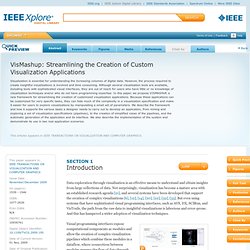
Not surprisingly, visualization has become a mature area with an established research agenda [21], and several systems have been developed that support the creation of complex visualizations [6], [12], [14], [20], [22], [32], [35]. But even using systems that have sophisticated visual programming interfaces, such as AVS, DX, SCIRun, and VisTrails, the path from the raw data to insightful visualizations is laborious and error-prone.
And this has hampered a wider adoption of visualization techniques. Fig. 1. Creating an Astrophysics VisMashup to explore a binary star system. View All | Next Visual programming interfaces expose computational components as modules and allow the creation of complex visualization pipelines which combine these modules in a dataflow, where connections between modules express the flow of data through the pipeline [16]. Our Approach. Run. The History of Programming Languages. For 50 years, computer programmers have been writing code.
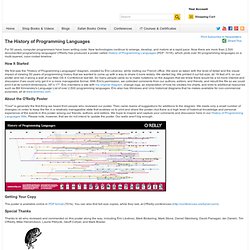
New technologies continue to emerge, develop, and mature at a rapid pace. Now there are more than 2,500 documented programming languages! O'Reilly has produced a poster called History of Programming Languages (PDF: 701K), which plots over 50 programming languages on a multi-layered, color-coded timeline. How It Started We first saw the "History of Programming Languages" diagram, created by Éric Lévénez, while visiting our French office. J. Paul Morrison. DrawFBP Diagramming Tool. Over the last several years, an FBP diagram drawing tool, written in Java, has been evolving.
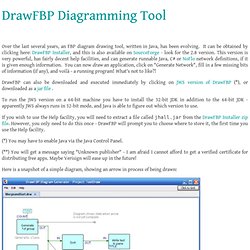
It can be obtained by clicking here: DrawFBP Installer, and this is also available on SourceForge - look for the 2.8 version. This version is very powerful, has fairly decent help facilities, and can generate runnable Java, C# or NoFlo network definitions, if it is given enough information. Asynchronous Component-Based Programming. It seems hardly worth pointing out that the universe we live in is a highly asynchronous place: it is a place where an infinite number of things are happening all at once.
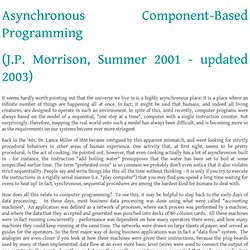
In fact, it might be said that humans, and indeed all living creatures, are designed to operate in such an environment. In spite of this, until recently, computer programs were always based on the model of a sequential, "one step at a time", computer with a single instruction counter. Not surprisingly, therefore, mapping the real world onto such a model has always been difficult, and is becoming more so as the requirements on our systems become ever more stringent Back in the '60s, Dr. Flow-Based Programming. Wiki: FlowBasedProgramming. Hot off the press!

A second edition of my book is now available from CreateSpace's eStore - and at Amazon.com - Take a look and see how FBP has changed in 15 years! The new edition contains information about the Java and C# implementations, as well as the diagramming tool (DrawFBP), several sections contributed by Mike Beckerle, CTO of Oco Inc., plus a whole new chapter on projects that have appeared in the last 15 years and either build on FBP, or have strong similarities to it. Patterns in Flow-Based Programming. (Apr., 2005) J.

Paul Morrison In recent years, the concept of "pattern" seems to be have caught the imagination of many in the information technology (IT) industry. This concept was developed extensively by C. FBP and the Jackson Inversion Model. Material from book starts here: In the middle years of this century, it was expected that eventually computers would be able to do anything that humans could explain to them.
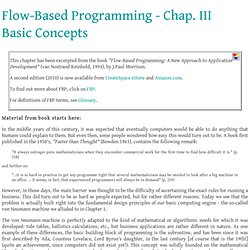
But even then, some people wondered how easy this would turn out to be. A book first published in the 1950's, "Faster than Thought" (Bowden 1963), contains the following remark: "It always outrages pure mathematicians when they encounter commercial work for the first time to find how difficult it is. " (p. 258) Jackson structured programming. Example of a JSP diagram.
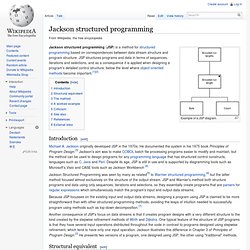
Jackson structured programming (JSP) is a method for structured programming based on correspondences between data stream structure and program structure. JSP structures programs and data in terms of sequences, iterations and selections, and as a consequence it is applied when designing a program's detailed control structure, below the level where object-oriented methods become important.[1][2] Introduction[edit] Jackson Structured Programming was seen by many as related[5] to Warnier structured programming,[6] but the latter method focused almost exclusively on the structure of the output stream. JSP and Warnier's method both structure programs and data using only sequences, iterations and selections, so they essentially create programs that are parsers for regular expressions which simultaneously match the program's input and output data streams. Hoare's report on JSP shows how it relates to his later idea of CSP.
Hoare's seminal book on CSP. Pypes. Vvvv - a multipurpose toolkit. Patch Schematics – The Aesthetics of Constraint / Best Practices / guest post by Paul Prudence (@MrPrudence) Visual programming languages, languages that create programs by the manipulation of graphical elements, as opposed to specifying lines of text, have seen an increased popularity in recent years both in audio and video synthesis. Some of the more well-known environments, ones that are regularly used for projects that are featured on CAN, include VVVV (real-time motion graphics and physical IO) MAX/MSP (real-time music and multimedia), Pure Data (ostensibly an open source equivalent of MAX/MSP) and Quartz Composer (video synthesis for MAC).
VPL Introduction. Microsoft Visual Programming Language (VPL) is an application development environment designed on a graphical dataflow-based programming model. Rather than series of imperative commands sequentially executed, a dataflow program is more like a series of workers on an assembly line, who do their assigned task as the materials arrive. Robotics Developer Studio. <a id="b7777d05-f9ee-bedd-c9b9-9572b26f11d1" target="_self" class="mscom-link download-button dl" href="confirmation.aspx?
Id=29081" bi:track="false"><span class="loc" locid="46b21a80-a483-c4a8-33c6-eb40c48bcd9d" srcid="46b21a80-a483-c4a8-33c6-eb40c48bcd9d">Download</span></a> Microsoft® Robotics Developer Studio 4 is a freely available .NET-based programming environment for building robotics applications. It can be used by both professional and non-professional developers as well as hobbyists. DetailsMicrosoft Robotics Developer Studio 4.exe Microsoft® Robotics Developer Studio 4 enables hobbyists and professional or non-professional developers to create robotics applications targeting a wide range of scenarios.
Institut für Computergraphik und Algorithmen - Arbeitsgruppe für Computergraphik. Information Publication Type: Master Thesis First Supervisor: Martin Haidacher Keywords: Rapid Development, Dataflow Programming, Visual Programming, Visualization Abstract Over the years, many visualization tools and applications were developed for specific fields of science or business. Staying in the alcove of their field, these are highly suited and optimized for visualizing specific data, with the drawback of not being flexible enough to extend or alter these visualizations for other purposes. Often, customers of such visualization packages cannot extend them, to fit their needs, especially if the software is closed source. The goal of this thesis is to develop a dataflow visual programming language (DFVPL) and a visual editor for the rapid development of visualizations. This programming language and its editor run platform independently to reach a high number of potential programmers, respectively users, to develop visualizations, since they are not bound to a specific platform.
TPL Dataflow. Audiotool. Audio visualizer, music visualizer, visual programming language (VPL), realtime graphics design platform. OpenMDX - Open Source MDA platform / Wiki / Home. What is AudioMulch? AudioMulch is an interactive musician's environment for PC and Mac. It is used for live electronic music performance, composition and sound design. AudioMulch allows you to make music by patching together a range of sound producing and processing modules. Unlike some patcher-based programming environments, AudioMulch's modules perform high-level musical functions, so you don't have to create things from the ground up using individual oscillators and filters. AudioMulch is designed for live performance and improvisation - you can process live audio sources and control every knob and slider on the user interface using a MIDI controller. Learn more about AudioMulch's capabilities below... AudioMulch is sometimes hard for people to grasp so imagine it this way.
But what if, while you were playing, the guitar could be repatched via the filters in the synth, the trumpet routed through the fuzz pedal and tape delay, the drum machine used to gate the keys? AudioTechnology, March 2010 Modules. Grasshopper - generative modeling for Rhino. 2.6/Manual/Render/Cycles/Nodes. From BlenderWiki Materials, lights and backgrounds are all defined using a network of shading nodes. These nodes output values, vectors, colors and shaders. Shaders An important concept to understand when building node setups is that of the shader socket. The output of all surface and volume shaders is a shader, describing lighting interaction at the surface or of the volume, rather than the color of the surface. There are a few types of shaders available as nodes: BSDF shader describing light reflection, refraction and absorption at an object surface.
Each shader node has a color input, and outputs a shader. Introduction to Houdini's Node Based Workflow. Download Video - 49MB [16 Min.]Download Torrent. Welcome. Introversion Software . Subversion. Population. Idflood/ThreeNodes.js. IMPURE. Live Coding: Automated Artistic "Performances" Using Linux's Kernel. We’ve been hearing the warnings from cautious futurists for years—one day, computer automation and robots would become so advanced as to be able to produce anything, perhaps even art.
Though the creative and social implications of this forecast have been explored by generative artists for years now, we have yet to see any fully automated programs emerge wherein the computer creates art completely independently of the artist (even in generative art, humans still outline the parameters for the ensuing visuals through code). What if the computer programmed itself using that same generative technique, moving the possibilities of “computer-generated art” ever further down the rabbit hole of automation? That’s the question being explored in the two projects below. The second project is a machine designed to self-program itself, leaving the human factor by the wayside almost completely. Sketching Dynamic Geometry.